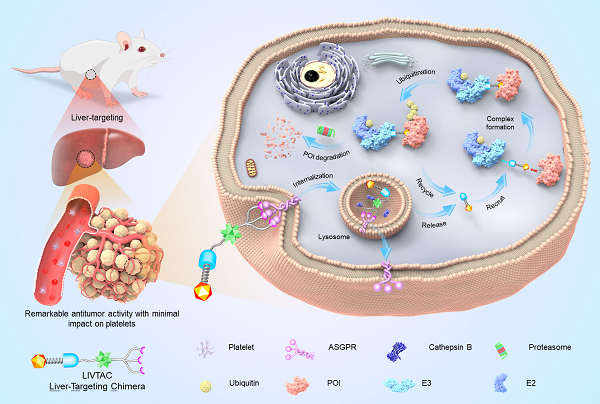
Liver cancer ranks as the fourth most common cancer and the second leading cause of cancer-related deaths in China, with hepatocellular carcinoma (HCC) being the most prevalent type. Current treatments for liver cancer encounter several significant challenges, including limited target availability, severe side effects, low response rates, and the emergence of acquired drug resistance.
Recent advances in proteolysis-targeting chimera (PROTAC) technology offer promising improvements in drug efficacy through its unique catalytic protein degradation mechanism. However, conventional PROTACs have limitations, such as inadequate tissue targeting, need for substantial efforts to enhance bioavailability, and specific formulations required due to poor water solubility.
In a study published in Journal of Controlled Release, a research team led by Prof. ZHANG Xuan from the Shanghai Institute of Materia Medica (SIMM) of the Chinese Academy of Sciences (CAS), and Prof. HE Yonghan from the Kunming Institute of Zoology of CAS, introduced a novel class of protein degraders known as Liver-targeting chimeras (LIVTACs). These agents were designed to precisely degrade target proteins within the liver with their anticancer efficacy and preliminary safety profile validated in HCC animal models.
Bromodomain and extra-terminal (BET) proteins are closely linked to the progression of HCC, and several BET inhibitors are currently undergoing clinical trials. However, these inhibitors often suffer from 'on-target, off-tissue' toxicities, such as thrombocytopenia, which limits their efficacy and safety.
In this proof-of-concept study, the researchers exploited the high expression of asialoglycoprotein receptors (ASGPR) in liver parenchymal cells by strategically conjugating ASGPR ligands with a BET degrader using a CTB-cleavable linker. This approach enabled precise cellular uptake and subsequent release of active PROTAC degraders within the liver.
XZ1606, the representative LIVTAC, demonstrated exceptional efficacy in degrading BRD4 protein and exhibited strong antiproliferative activity in vitro. Mechanistic studies revealed that the cellular activity largely depends on ASGPR expression, suggesting the potential for an improved therapeutic window.
In vivo experiments further confirmed the therapeutic potential of XZ1606. In Huh7 xenograft mouse models, XZ1606 exhibited remarkable antitumor activity, significantly reducing tumor size in the treatment group. Additionally, the combination therapy of XZ1606 with sorafenib resulted in long-term tumor growth suppression and significantly extended the overall survival of the tumor-bearing mice. Notably, this combination therapy did not exhibit the platelet toxicity commonly associated with traditional BET inhibitors, underscoring XZ1606’s favorable safety profile.
This study shows that LIVTAC provides a targeted solution by precisely focusing on liver cells, thereby minimizing side effects. It establishes LIVTAC as a promising therapeutic approach for HCC, and highlights its potential as a versatile platform for addressing a wide range of liver diseases.

Mechanism of action of LIVTAC molecules (Image by Prof. ZHANG's Lab)

86-10-68597521 (day)
86-10-68597289 (night)

52 Sanlihe Rd., Xicheng District,
Beijing, China (100864)

